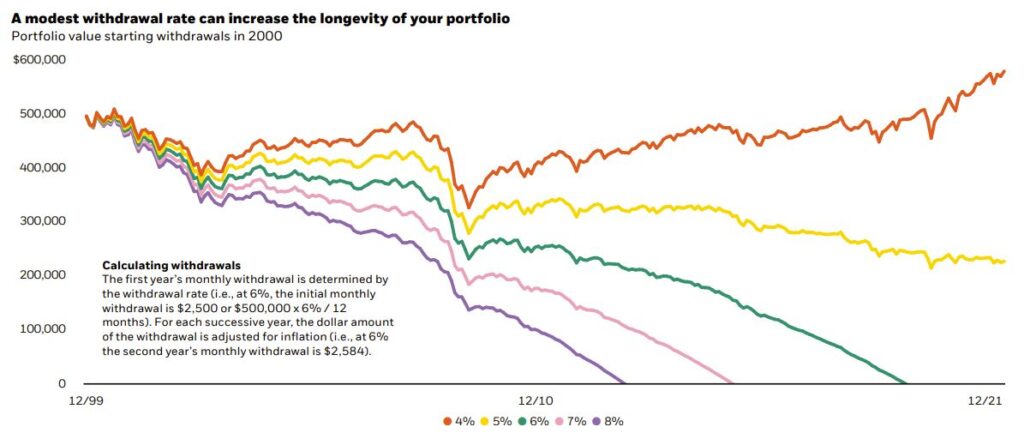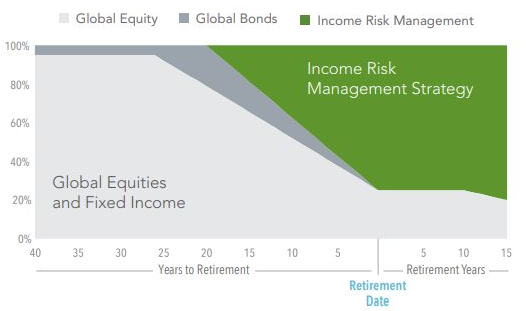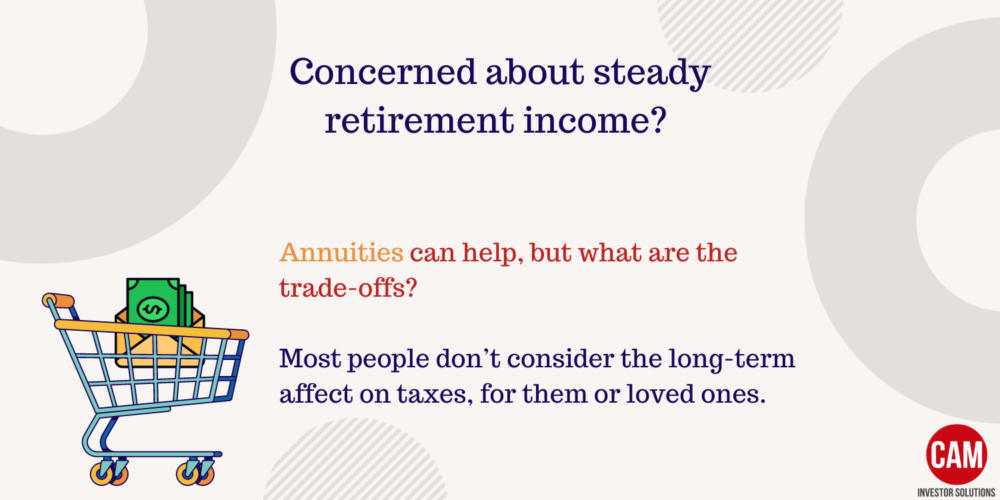Are you a W-2 employee but your employer doesn't offer a 401(k) plan and you want to save for retirement? Read about your options.

Investment Planning Throughout Retirement
Investment planning during retirement is not the same as investing FOR retirement and, in many ways, is more complicated.
Your working years are your saving years. With luck, your income increases from year to year; those increases offer some protection against rising costs caused by inflation. While you’re working, your retirement objective generally is to grow retirement savings as much as possible, and investments that offer higher potential reward in exchange for greater potential for volatility and/or loss are often the focus for those retirement savings.
When you retire, on the other hand, spending rather than saving becomes your focus. Your sources of income may include Social Security, employer pensions, personal savings and assets, and perhaps some income from working part-time. Typically, a retiree’s objective is to derive sufficient income to maintain a chosen lifestyle and to make assets last as long as necessary.
This can be a tricky balancing act. Uncertainty abounds – you don’t know how long you’ll live or whether rates of return will meet your expectations. If your income is fixed, inflation could erode its purchasing power over time, which may cause you to invade principal to meet day-to-day expenses. Or, your retirement plan may require that you make minimum withdrawals in excess of your needs, depleting your resources and triggering taxes unnecessarily. Further, your ability to tolerate risk is lessened – you have less time to recover from losses, and you may feel less secure about your finances in general.
How, then, should you manage your investments during retirement given the above complications? The answer is different for everyone. You should tailor your plans to your own unique circumstances, and you may want to consult a financial planning professional for advice.
The following discusses two important factors you should consider: (1) withdrawing income from retirement assets, and (2) balancing safety with growth.
Choosing a Sustainable Withdrawal Rate
A key factor that determines whether your assets will last for your entire lifetime is the rate at which you withdraw funds. The more you withdraw, the greater the likelihood you’ll exhaust your resources too soon. On the other hand, if you withdraw too little, you may have to struggle to meet expenses; also, you could end up with assets in your estate, part of which may go to the government in taxes. It is vital that you estimate an appropriate withdrawal rate for your circumstances, and determine whether you should adjust your lifestyle and/or estate plan.
Your withdrawal rate is typically expressed as a percentage of your overall assets, even though withdrawals may represent earnings, principal, or some combination of the two. For example, if you have $500,000 in assets and decide a 4 percent withdrawal rate is appropriate, the portfolio would need to earn $20,000 a year if you intend to withdraw only earnings; alternatively, you might set it up to earn $10,000 in interest and take the remaining $10,000 from the principal. An appropriate and sustainable withdrawal rate depends on many factors including the value of your current assets, your expected rate of return, your life expectancy, your risk tolerance, whether you adjust for inflation, how much your expenses are expected to be, and whether you want some assets left over for your heirs.
Fortunately, you don’t have to make a wild guess. Studies have tackled this issue, resulting in the creation of tables and calculators that can provide you with a range of rates that have some probability of success. However, you’ll probably need some expert help to ensure that this important decision is made carefully. This chart below is just one of how your withdrawal rate can affect the longevity of your retirement assets.

Withdrawing first from taxable, tax-deferred, or tax-free accounts
Many retirees have assets in various types of accounts–taxable, tax-deferred (e.g., traditional IRAs), and tax-free (e.g., Roth IRAs). Given a choice, which type of account should you withdraw from first? The answer–it depends.
Caution: Roth IRA earnings are generally free from federal income tax if certain conditions are met, but may not be free from state income tax.
- Retirees who will not have an estate
For retirees who do not intend to leave assets to beneficiaries, the answer is simple in theory: Withdraw money from a taxable account first, then a tax-deferred account, and lastly, a tax-free account. This will provide for the greatest growth potential due to the power of compounding.
In practice, however, your choices, to some extent, may be directed by tax rules. Retirement accounts, other than Roth IRAs, have minimum withdrawal requirements. In general, you must begin withdrawing from these accounts by April 1 of the year following the year you turn age 70½. Failure to do so can result in a 50 percent excise tax imposed on the amount by which the required minimum distribution exceeds the distribution you actually take.
- Retirees who will have an estate
For retirees who intend to leave assets to beneficiaries, the analysis is more complicated. You need to coordinate your retirement plan with your estate plan.
If you have appreciated or rapidly appreciating assets, it may be more advantageous for you to withdraw from tax-deferred and tax-free accounts first. This is because these accounts will not receive a step-up in basis at your death, as many of your other assets will, and your heirs could face a larger than necessary tax liability.
However, this may not always be the best strategy. For example, if you intend to leave your entire estate to your spouse, it may be better to withdraw from taxable accounts first. This is because spouses are given preferential tax treatment with regard to retirement plans. As a beneficiary of a traditional IRA or retirement plan, a surviving spouse can roll over retirement plan funds to his or her own IRA or retirement plan, or, in some cases, may continue the deceased spouse’s plan as his or her own. The funds in the plan continue to grow tax deferred, and distributions need not begin until the spouse’s own required beginning date.
For retirees who have a “stretch” IRA, you may want to take advantage of your ability to defer taxes over a number of generations.
Tip: Retirees in this situation should consult a qualified estate planning attorney who has some expertise with regard to retirement plan assets.
Balancing safety and growth
When you retire, you generally stop receiving income from wages, a salary, or other work-related activity and start relying on your assets for income. To ensure a consistent and reliable flow of income for your lifetime, you must provide some safety for your principal. This is why retirees typically shift at least a portion of their investment portfolio to more secure income-producing investments, and this makes a great deal of sense.
Unfortunately, safety comes with a price – reduced growth potential and erosion of value due to inflation. Safety at the expense of growth can be a critical mistake for some retirees. On the other hand, if you invest too heavily in growth investments, your risk is heightened, and you may be forced to sell during a downturn in the market should you need more income. Retirees must find a way to strike a reasonable balance between safety and growth.
One solution may be the “two bucket” approach. To implement this, you would determine your sustainable withdrawal rate (see above), and then reallocate a portion of your portfolio to fixed income investments (e.g., certificates of deposit and bonds) that will provide you with sufficient income for a predetermined number of years. You would then reallocate the balance of your portfolio to growth investments (e.g., stocks) that you can use to replenish that income “bucket” over time.
The fixed income portion of your portfolio should be able to provide you with enough income (together with any other income you may receive, such as Social Security and required minimum distributions from retirement plans) to meet your expenses so you won’t have to liquidate investments in the growth portion of your portfolio at a time when they may be down. This can help you ride out fluctuations in the market, and sell only when you think a sale is advantageous.

Be sure that your fixed income investments will provide you with income when you’ll need it. One way to accomplish this is by laddering. For example, if you’re investing in bonds, instead of investing the entire amount in one issue that matures on a certain date, spread your investment over several issues with staggered maturity dates (e.g., one year, two years, three years). As each bond matures, reinvest the principal to maintain the pattern.
As for the growth portion of your investment portfolio, common investing principles still apply:
- Diversify your holdings
- Invest on a tax-deferred or tax-free basis if possible
- Monitor your portfolio and reallocate assets when appropriate
Caution: For retirees investing in bonds, don’t assume that individual bonds and bond funds are the same type of investment. Bond funds do not offer the two key characteristics offered by bonds: (1) income from bond funds is not fixed – dividends change depending on the bonds the fund has bought and sold as well as the prevailing interest rate, and (2) a bond fund does not have an obligation to return principal to you when bonds within the fund mature. Additionally, the risk associated with bond funds varies depending on the bonds held within the fund at any given time, whereas the risk associated with individual bonds generally decreases over time as a bond nears its maturity date (assuming the issuer’s financial situation doesn’t deteriorate). Finally, fees and charges associated with bond funds reduce returns. Even so, you may still find bond funds attractive because of their convenience. Just be sure you understand the differences between bond funds and individual bonds before you invest.
Whether you’re nearing retirement or currently enjoying it, it can never hurt to seek professional advice. We do it all the time for our health, taxes and home repairs – ensuring your financial future is financially secure is no different. If we can provide a second opinion or help answer any of your questions, we would be happy to.
Sources: Broadridge Advisor Solutions; BlackRock; Informa Investment Solutions. This graphic looks at the effect that the amount withdrawn from a portfolio has on how long that portfolio may last. A prudent withdrawal rate (3% to 5%, adjusted and revisited annually) can increase the probability of success. Other factors that may affect the longevity of assets include the investment mix, taxes, expenses related to investing and the number of years of retirement funding (life expectancy). This is a hypothetical illustration starting at the beginning of a severe stock market downturn in 2000 to 2002. Beginning withdrawals in a rising market could improve the longevity of your portfolio. The portfolio is made up of 50% stocks and 50% bonds. Stocks are represented by the S&P 500 Index. Bonds are represented by the Bloomberg Aggregate Bond Index. Inflation is represented by the Consumer Price Index. This illustration assumes a hypothetical initial portfolio balance of $500,000 as of December 31, 1999, and monthly withdrawals beginning in 2000. Each monthly withdrawal is adjusted annually for inflation. Each portfolio is rebalanced monthly. All dividends and interest are reinvested. Results will vary based on selection of other time frames and over time as assumptions change. These figures are for illustrative purposes only and do not represent any particular investment, nor do they reflect any investment fees or expenses, or taxes. It is not possible to invest directly in an index. Past performance is no guarantee of future results.
M & A Consulting Group, LLC, doing business as CAM Investor Solutions is an SEC registered investment adviser. As a fee-only firm, we do not receive commissions nor sell any insurance products. We provide financial planning and investment information that we believe to be useful and accurate. However, there cannot be any guarantees. This blog has been provided solely for informational purposes and does not represent investment advice or provide an opinion regarding fairness of any transaction. It does not constitute an offer, solicitation or a recommendation to buy or sell any particular security or instrument or to adopt any investment strategy. Any stated performance does not reflect the expenses associated with the management of an actual portfolio. Past performance is not a guarantee of future results. Diversification does not eliminate the risk of market loss. Charts and graphs provided herein are for illustrative purposes only. There are many different interpretations of investment statistics and many different ideas about how to best use them. Nothing in this presentation should be interpreted to state or imply that past results are an indication of future performance. Tax planning and investment illustrations are provided for educational purposes and should not be considered tax advice or recommendations. Investors should seek additional advice from their financial advisor or tax professional.



